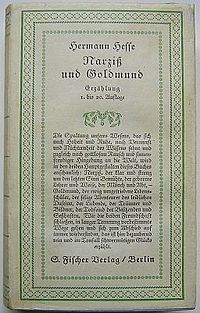Narcissus and Goldmund
by Hermann Hesse
Narcissus and Goldmund is the story of a young man, Goldmund (), who wanders aimlessly throughout Medieval Germany after leaving a Catholic monastery school in search of what could be described as "the meaning of life".
Narcissus (German: "Narziss or, before the German spelling reform of 1996, Narziß ), a gifted young teacher at the cloister school, quickly befriends Goldmund, as they are only a few years apart, and Goldmund is naturally bright. Goldmund looks up to Narcissus, and Narcissus has much fondness for him in return. After straying too far in the fields one day on an errand gathering herbs, Goldmund comes across a beautiful Gypsy woman, who kisses him and invites him to make love. This encounter becomes his epiphany; he now knows he was never meant to be a monk. With Narcissus' help, he leaves the monastery and embarks on a wandering existence.
Goldmund finds he is very attractive to women, and has numerous love affairs. After seeing a particularly beautiful carved Madonna in a church, he feels his own artistic talent awakening and seeks out the master carver, with whom he studies for several years. However, in the end Goldmund refuses an offer of guild membership, preferring the freedom of the road. When the Black Death devastates the region, Goldmund encounters human existence at its ugliest. Finally, after being imprisoned and set to be executed, he is reunited with and saved by his friend Narcissus, now an abbot, and the two reflect upon the different paths their lives have taken, contrasting the artist with the thinker.
The timeline and geography of the narrative is left somewhat vague, as the tale is rather abstract, and there is little attempt at historical accuracy. For example, some of Narcissus and Goldmund's discussions of philosophy and science sound too modern to have taken place during medieval times.
